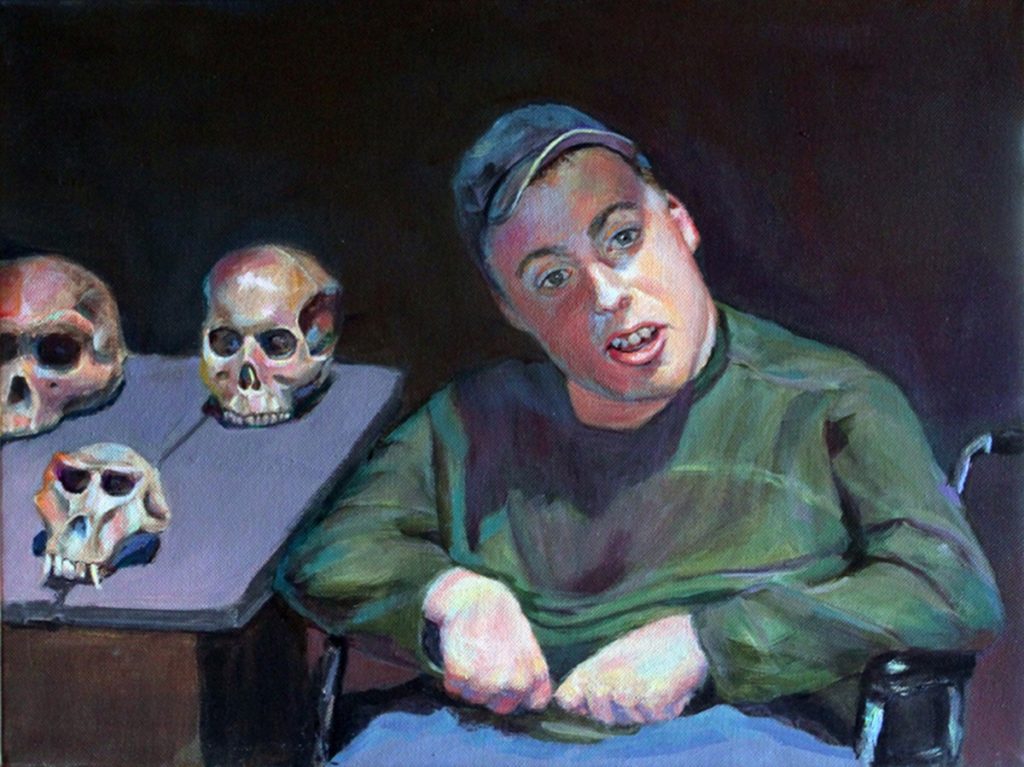Primum non nocere (First do no harm) is a fundamental moral and ethical principle that is the basis of medicine’s Hippocratic Oath. It begs the question, “To what or to whom?” The answer is obscured in a bewildering array of laboratory results, tubes, scans and telemetry.
This dehumanizing process is often confounded by the use of medical nomenclature. When a patient is described as being in a “vegetative state,” the patient’s identity is completely transformed beyond all recognition. The postmodern French philosopher, Jean Baudrillard, set forth what he called a precession continuum. Society substitutes symbols for reality. As a result, we lose the original meaning. Contemporary medicine is hurrying along this continuum.

The subject of my painting, Homage to the Real Eric, is my patient, Eric. At the age of 19, he was hit by a truck and sustained a near-lethal head injury. In this painting, he is 30 years old. The real or original subject is the younger, fully-abled Eric prior to the accident. I never knew this Eric. We first met when Eric presented to the emergency room in coma and on life support. He had already metamorphosed into his counterfeit twin: the patient.
Eric remained comatose for four months and required a respirator and a feeding tube. His pathologic self, the injured patient, produced symptoms and signs. His original self was under siege. His doctors counterattacked with technology. Infections were stopped by intravenous antibiotics; blood clots were prevented with a vena cava filter; brain pressure was lowered with surgery and a silastic shunt; paralysis and spasm alleviated via medicines and a battery-operated pump. All the while, his family and teenage friends stood vigil in the Intensive Care Unit (ICU) and monitored every intervention. Their hope kept the original Eric alive. Acceptance of his replacement, if it ever came, would be years away.
Eric passed the time unaware that his body produced yet more challenges for the medical staff. During a two-year period, Eric had over eight surgeries and procedures. By the time he was stable enough for transfer to a rehabilitation facility, technology had created a new Eric, hardly recognizable as the original, even to his family. In severely ill or injured patients, the disease and the grave secondary problems that follow gain more relevance than the person. After such exhaustive care, the patient becomes the diagnosis – in Eric’s case, “traumatic brain injury.” The counterfeit Eric lived while his original unique identity died.
The current Eric, depicted wheelchair-bound in my painting, has devolved from his original self. On the adjacent table are primate skulls depicting evolution. Hominids have evolved while Eric has devolved. His disabled body conspires against him. There are still more signs of damage, such as seizures and extremity contractures. But along the way, shards of his previous personality slowly emerge, including his often funny (and scatological) use of language. His real, original identity means nothing to Eric or to me; it only matters to those who knew him before his injury. And as time moves on and the years since the injury increase, the number of people who had the privilege of knowing the original Eric diminish. Someday, references to the pre-injury young man will cease to exist, and the real Eric will have been erased.
The CT scan of his brain reduces Eric to a computer-generated, hyperreal slice of 2-D grey scale. The CT scan is a neurosurgeon’s Morse code. By reading the code, a neurosurgeon can comprehend the patient’s neurological condition. Given our trust in radiology and technology, the physical presence of the patient is almost unnecessary. Indeed the radiologist often does the official review of these scans after the patient has left the facility. These practitioners never even know the patient. After all this time, I see value in each shift of his CT scan and in every crisis, surgery and in his lengthy crawl to recovery. Not knowing the original Eric haunts me. In the faint pixilation, I read the vague scrawl of an ancient oath now updated: “Pray, do no harm.”
To view an interview with Eric and his family, click here.
[aans_authors]








